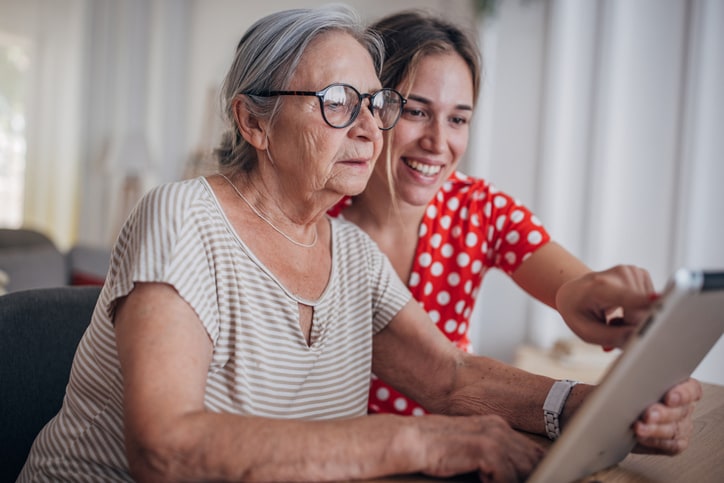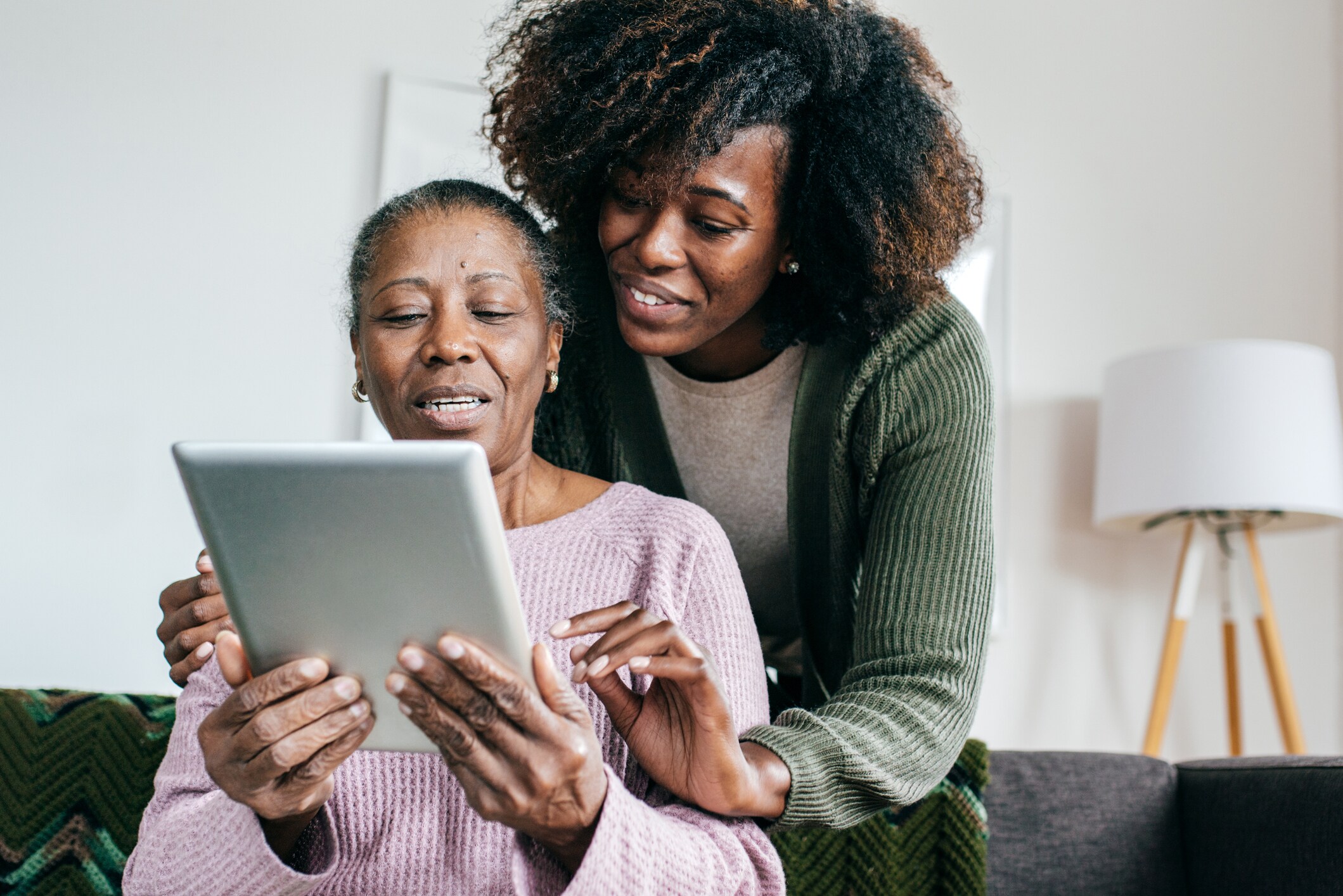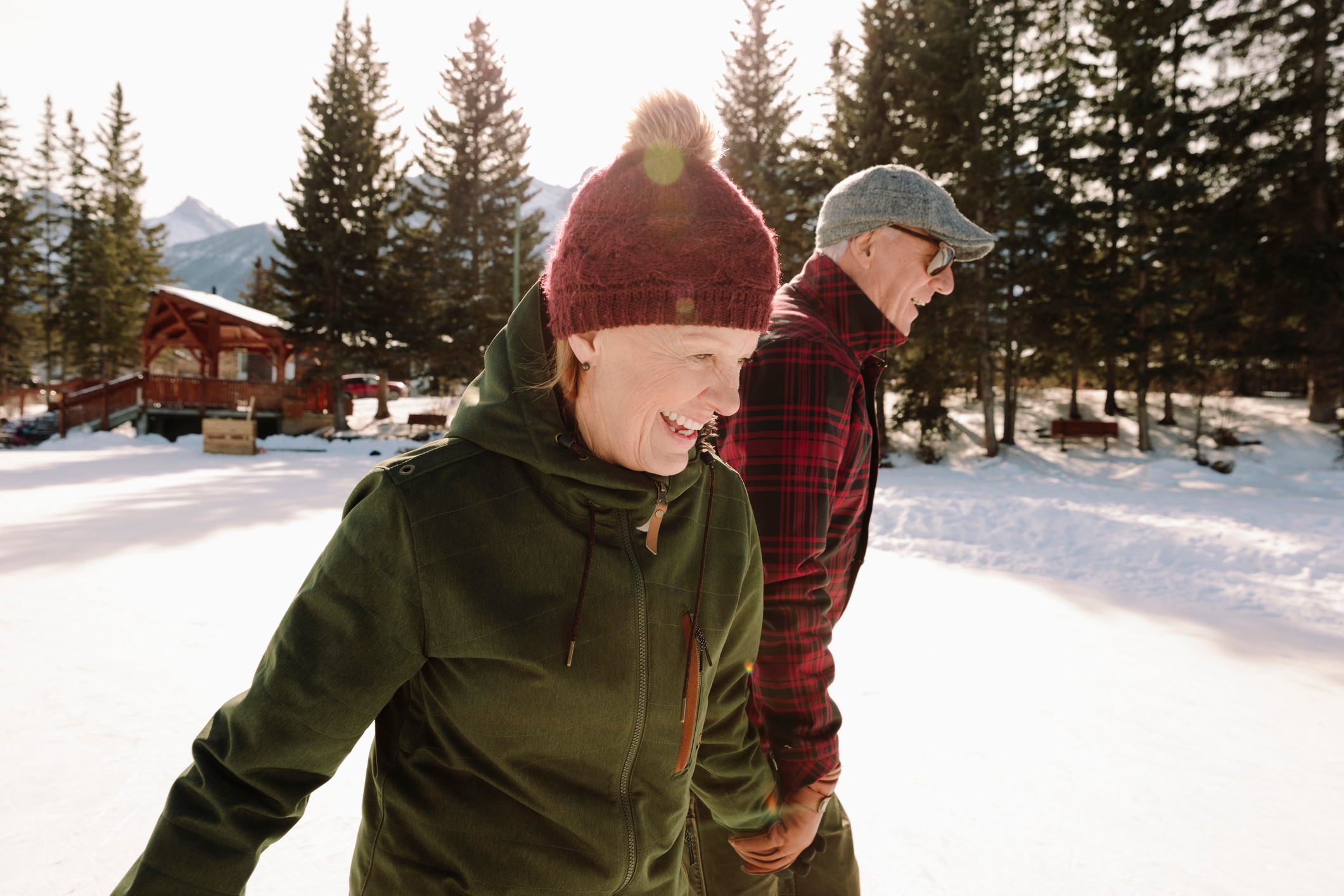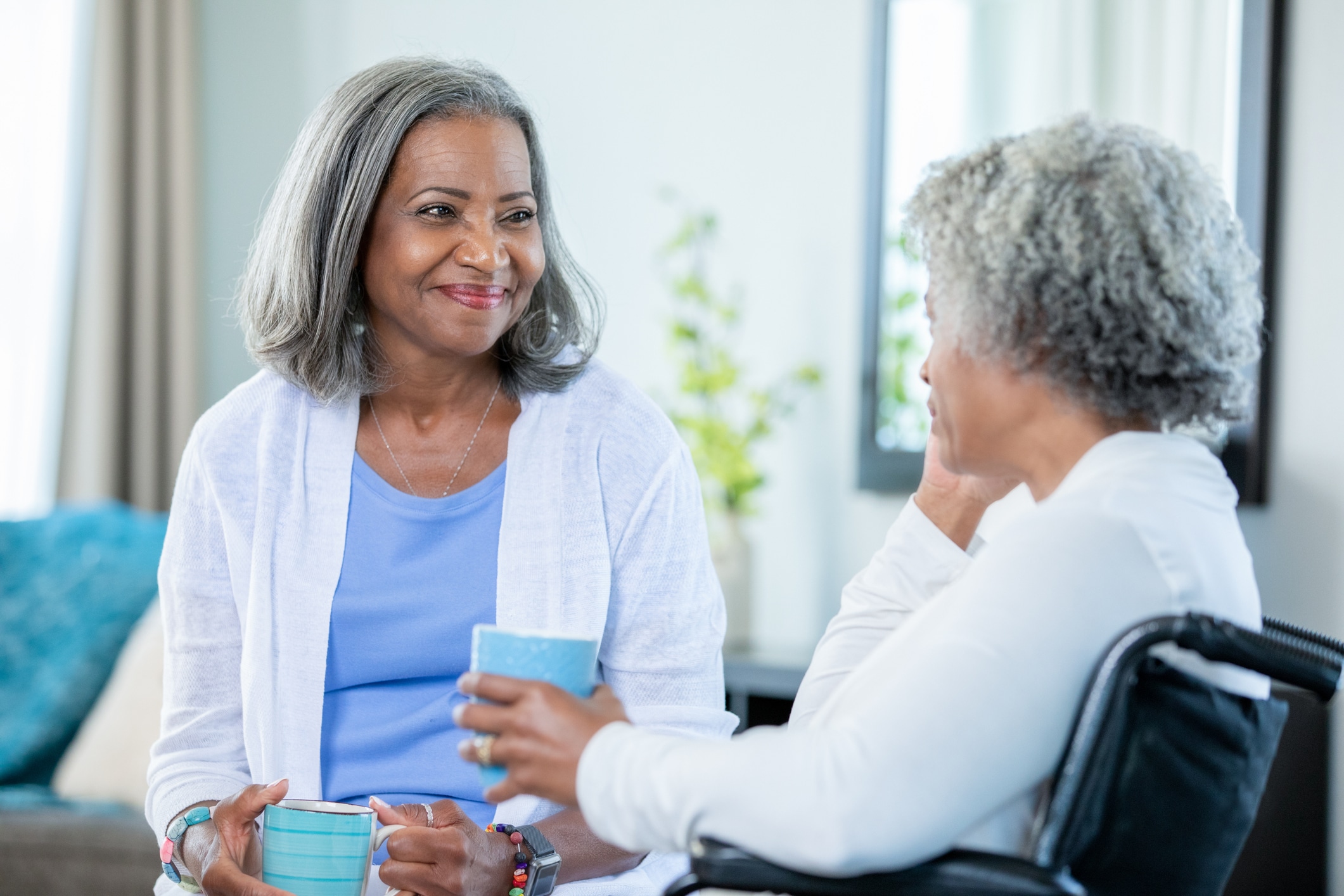In this article
- What are senior monitoring systems?
- What should I consider before getting an in-home senior monitoring system?
- What are the key features to look for when choosing monitoring systems for seniors?
- Newer remote monitoring options for seniors
- Privacy and security considerations
- The bottom line on senior monitoring systems
Being a family caregiver and navigating the journey of aging in place with a senior loved one comes with its fair share of challenges. From concerns about falls to worries about their overall well-being, the quest for peace of mind is real. That’s where senior monitoring systems step in, offering a lifeline of support and reassurance.
“From sensors that track movements and see heat patterns to wearable devices and vital sign patches, companies have developed all kinds of AgeTech solutions,” says Drew Schiller, CEO of Validic, a software company that helps healthcare organizations integrate a patient’s health data from wearables and home health devices into their electronic health record. AgeTech, a new era of tech-enabled products and services designed for the world’s aging population, is growing in tandem with life expectancy — now extending 20 years past the so-called retirement age.
For Schiller, this progress is particularly welcome: His 93-year-old grandparents still live in their home, with Schiller’s mom serving as their primary long-distance caregiver. Their story mirrors countless other families grappling with the complexities of ensuring their senior loved ones’ ongoing health and safety while caregiving from afar.
Read on to learn more about what senior monitoring systems are, when to consider one and key features to look for if you do — including privacy and security policies.
Key takeaways
- Senior monitoring systems can ease caregiver stress and support aging in place by detecting emergencies, tracking daily patterns and flagging subtle health changes — especially for long-distance caregivers. The right technology can offer peace of mind without sacrificing a senior’s independence.
- There’s no one-size-fits-all solution, so it’s important to start with basic home safety, clarify care goals and consult healthcare providers before choosing a system. Ease of use, reliability, medical certification and meaningful data sharing matter more than flashy features.
- AgeTech is evolving rapidly and becoming more integrated into healthcare, with wearables, sensors and remote monitoring increasingly tied to clinical care. As technology improves and adoption grows, these systems have the potential to make caregiving more proactive, personalized and effective.
What are senior monitoring systems?
Senior monitoring systems encompass a spectrum of technologies aimed at aiding caregivers and health care providers in identifying subtle changes in seniors’ health and behavior, while also serving as an emergency alert system. For example, if a senior living alone were to fall in the bathroom, a wearable device or sensor could detect the incident and promptly notify the designated caregiver, potentially summoning an ambulance if necessary.
Other home systems operate in the background continuously, utilizing things like sensors, cameras, and microphones to track daily movements, detecting anything outside the norm without the need for any active participation from a senior (i.e., they don’t need to wear anything). It’s these systems that address various concerns that caregivers may have, like wondering if their senior’s house is the right temperature, whether they’re sleeping too much or not enough, if they suffered a fall or if they left the house.
While a large majority of systems and devices are only available through healthcare systems and insurance companies, there are some consumer options tailored to the needs of long-distance caregivers.
Types of remote monitoring technologies
- Wearables such as smartwatches, fitness trackers, and patches monitor heart rate, activity level, detect falls, sleep patterns, etc.
- Motion sensors placed around the home alert caregivers if any abnormal movement patterns are detected, such as 2 a.m. movement in the kitchen when there isn’t usually any activity until 7 a.m..
- Virtual caregiving systems assist with various tasks like giving medication reminders or demonstrating a rehab exercise.
- Telehealth enabled-devices allow for real-time video or audio between seniors and healthcare providers.
- Home monitoring devices include things like sleep apnea machines and blood glucose monitors.
- Home security systems include a combination of cameras and motion sensors that alert caregivers to any abnormal activity and things like fire, carbon monoxide, and smoke.
- Medical alert systems provide immediate assistance in the event of a medical emergency, such as a fall or a heart attack.
What should I consider before getting an in-home senior monitoring system?
Aging in place requires a home free from obstacles and dangers, but before committing to a senior monitoring system, Megan McVane, a social worker who directs home-based care for veterans in Illinois, suggests taking a moment to figure out what you really want it to accomplish. “Just putting up a camera won’t stop a fall,” she points out. “Start with simpler things, like making sure there’s enough light, clearing away any tripping hazards, getting regular eye check-ups and checking their hearing.”
Once you’ve addressed any home safety modifications, it’s worth checking in with your loved one’s primary care provider for monitoring system recommendations — especially if they have a chronic condition.
If you need additional support and guidance on your caregiving journey, consider connecting with geriatric social workers at your local hospital or primary care center, advises McVane, who previously worked as hospital-based social worker at Northwestern’s Transitional Care Clinic. “Families need to know they don’t need to go through this alone; many social workers have dedicated their careers to the health and well-being of seniors in the community and have expertise to share,” she says.
And if you need more help, McVane suggests reaching out to your own or your senior loved one’s insurance provider (such as original Medicare or Medicare Advantage) and asking to speak with their patient services department. From there, you can often learn about special programs and benefits they offer related to senior monitoring systems.
“I’ve seen plenty of seniors skeptical of technologies working for them. But when they understand why it’s important to monitor certain vital signs in connection with their health, they’re at least more willing to give it a try.”
— Megan McVane, social worker who directs home-based care for veterans
What are the key features to look for when choosing monitoring systems for seniors?
When comparing available options for a senior monitoring system, consider yours and your senior loved one’s comfort level with technology and look into the device’s reliability, certification, and data sharing capabilities.
Ease of use
Technology should be effortless to use, but that’s not the world we live in quite yet. Digital literacy often stands in the way of seniors’ adherence to (or willingness to try) wearables or have sensors in their home.
Patient education plays a significant role in bridging this gap. For instance, the VA’s Digital Divide program has social workers who will go to a senior’s home, get the technology all set up, and then train the patient and caregivers on how to use it. “I’ve seen plenty of seniors skeptical of technologies working for them,” says McVane. “But when they understand why it’s important to monitor certain vital signs in connection with their health, they’re at least more willing to give it a try.”
Reliability
Long-distance caregiving comes with very unique challenges, particularly around ensuring consistent and reliable monitoring. When choosing a senior monitoring system, Kieran McNamara, general manager of Eseye North America, a technology company providing connectivity services to senior monitoring devices, recommends selecting one with cellular connectivity. “Unlike WiFi or Bluetooth, cellular networks provide extensive coverage and maintain stability even amid power and internet disruptions,” he says.
While other systems may be cheaper, cellular enables the healthcare team and caregiver to get live alerts and health data updates. (Not to mention, cellular devices tend to be more user-friendly and generally work right out of the box.)
Certification and reputation
“Always choose devices that are compliant with [FDA] health and safety standards, and opt for systems from reputable and verified manufacturers that specialize in medical-grade devices specifically designed for your care needs,” says McNamara.
While some products marketed as senior monitoring systems are legally classified as “medical devices,” others are not. If you see a remote patient monitoring device marketed as “FDA approved” or “FDA cleared,” you can go to the Devices@FDA Database and enter the device or company name to verify the approval status of that device.
“Always choose devices that are compliant with [FDA] health and safety standards, and opt for systems from reputable and verified manufacturers that specialize in medical-grade devices specifically designed for your care needs.”
— Kieran McNamara, senior tech monitoring expert
Data sharing
You’ll do well to ask your or your senior loved one’s provider what health data is best to track in the first place and how to best share it with them, advises Schiller. “Unfortunately, you can’t expect them to have a solution — and it’s a gap we’re working to fill; if it doesn’t eventually get back to your doctor, then what’s the point?”
Let’s say your dad is a veteran with a long history of heart disease. Upon discharge from his last hospital visit, he was given special monitoring devices through the VA’s Remote Patient Monitoring-Home Telehealth (RPM-HT) program, which caters to those with chronic or high-risk conditions.
“The program has care coordinators on staff who monitor patient data coming in from their devices — things like blood pressure, blood sugar and heart rate,” says McVane. “If they notice any irregularities, they’ll call the patient and advise on whether in-person care is needed.”
Similar programs exist upon discharge from skilled nursing facilities and through certain Medicare Advantage plans. However, Schiller notes that these programs often target individuals at the highest risk, particularly through “hospital at home” programs.
Newer remote monitoring options for seniors
There isn’t any one senior monitoring system or technology that’s cornered the AgeTech market at any large scale, according to Schiller, who also serves on the Consumer Technology Association Executive Board. New devices and systems come on the market all the time. Here’s a few options worth considering.
Apple Watch Series 11
Released in 2025, the Apple Watch Series 11 is designed for people of all ages and is especially well-suited for seniors. It’s packed with an extensive list of safety, health monitoring and wellness features such as:
- Emergency SOS
- International emergency calling
- Fall detection
- Medication and appointment reminders
- Auto crash detection.
- Blood oxygen levels
- Heart rate and body temperature
- Steps
- Stress level
- Sleep patterns
If you’re setting up the watch for an aging parent, you can set yourself up as an emergency contact using the Apple Watch app on your iPhone: Go to My Watch > Emergency SOS > Emergency Contacts and add the names and phone numbers of people who you would want to be contacted in an emergency.
You may also want to check out “A Seniors Guide to Apple Watch Series 9, SE, and Ultra (With watchOS 10),” an easy-to-understand guide book that serves as a fantastic companion to any new Apple Watch wearer. Author Scott La Counte breaks down health metrics like blood oxygen and temperature sensors with detailed imagery to help you tailor your watch’s aesthetics and functionality.
Cost: $399-$799 + optional GPS + Cellular monthly plan of about $10 + optional AppleCare coverage
Lively Mobile2 from Best Buy Health
In March 2024, Lively from Best Buy Health released a new medical alert device called Lively Mobile2 that, according to its website, has the “fastest call time for 24/7 emergency help.” The device is designed to be taken anywhere — even in the shower — but it’s battery-powered and needs to be charged on a docking station when not in use.
For an additional monthly fee, you can enable LivelyMobile2’s fall detection feature that automatically connects you to one of Lively’s urgent response agents even if you can’t press the button. In the event of an emergency, designated caregivers will receive an alert on their phone through the Lively Link app.
When paired with either Basic or Premium Lively services, Lively Mobile2 can also connect you with Lively’s Social Care team at the push of a button — licensed social workers who can help seniors find grocery delivery options, coordinate transportation, manage prescriptions, get refills over the phone and more.
Cost: $79.99 + $24.99 (basic) or $34.99 (premium) monthly subscription, activation fee and taxes + optional $9.99 fall detection services monthly subscription
Note: Lively Mobile2 is available as a no-cost benefit of select Medicare and Medicaid insurance plans and may be covered by your HSA, FSA, or HRA spending accounts. Check with your provider.
Caregiver Smart Solutions Core Kit
If you’re looking for a system that’s a bit more discrete and allows your senior loved one to maintain their sense of independence, Caregiver Smart Solutions Core Kit might be a good option; it forgoes cameras and microphones for movement sensors to track activity in the home.
Sensor technologies and data analysis can automatically identify abnormal behavior, such as a senior who normally wakes up early suddenly staying in bed most of the day or frequent visits to the bathroom during the night, signs of cognitive impairment, falling, and sleep quality. Caregivers can receive updates and alerts in real-time using the system’s app on their phone.
The Core Kit includes:
- 14 Sensors
- 1 Smart Hub
- Movement sensors in five rooms
- Medicine cabinet, refrigerator, temperature and humidity sensors
- Front and side door sensors
- Emergency buttons
Cost: $899 + $59 monthly subscription
Privacy and security considerations
When it comes to choosing a senior monitoring system, McNamara says caregivers and seniors should feel clear on the following:
- What data is collected, and why?
- How is the data stored and protected?
- Who has access to the data?
- Is the system or device compliant with privacy laws such as HIPAA?
Health and wellness apps that do not claim to be HIPAA-compliant are often not, per research in the British Medical Journal, and they may be profiting from your information. For example, a 2016 investigation in Scientific American found Pfizer spends $12 million annually to buy people’s health data from a variety of sources.
The Office of the National Coordinator for Health Information Technology recommends reading the terms of service and the privacy notice of the mobile app to verify that the app will perform only the functions you approve; think about using a different app if you do not agree with their functions and consider installing or using encryption software for your device.
Join Care for free
The bottom line on senior monitoring systems
Choosing the right senior monitoring system is a meticulous process that may involve going through many different solutions before finding what works best for you or your senior loved one — with the understanding that what works best may change over time. As many more monitoring technologies go to market over the next several years, they’re bound to be easier to use, more reliable and more secure.
“The AgeTech space is very much in evolution, and we also have a new generation of millennial doctors entering the workforce who are very used to technology — and having technology to do things better,” says Schiller. “I think we’ll get to a place where the health data generated from these monitoring systems can have a real impact on people’s lives.”





